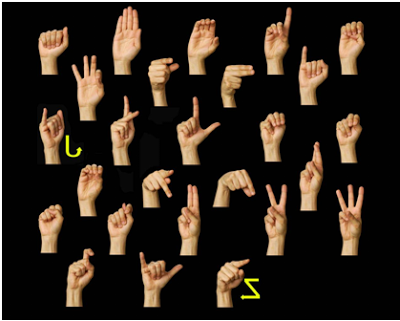Recently, as a counter-attack against Karl Lagerfeld’s
opinions about her being in need of weight loss, singer Adele made the
following statement famous: “I make music for the ears, not for the eyes”. Leaving
aside her fabulous reply, can we really say that music is exclusive for those
able to hear or may a visual component be determinant in some cases?
Sign Language uses manual communication and
body language to convey meaning. It is mainly used by deaf people or those who
want to communicate with them, family members, friends or interpreters, for
instance.
Sing language derives, in any case, from oral
language. Contrary to what most people think, sign language is not universal,
in fact, there are different sign languages depending on the country/region we
refer to. For instance, we find Spanish Sign Language, French Sign Language,
Greek Sign Language… but also American Sign Language and British Sign Language!
Here you have an example of four different ways of saying "How are you?":
Here you have an example of four different ways of saying "How are you?":
American Sign Language (ASL)
British Sign Language (BSL)
Australian Sign Language (AUSLAN)
Lengua de Signos Española (LSE)
But let’s go back to the music issue. Although
deaf people cannot perceive any sound, they can, however, feel the vibrations. And this applies, therefore, to the vibrations produced by the tunes of any song.
As vibrations are felt, rhythm may also be followed, so music, which is
basically conceived for hearers, can be also enjoyed by deaf people in some
way.
Have a look at the video below, where Stephen
Torrence “signs” or we might say “sings” a song from Miley Cyrus, "Party in the
USA":
In this video we can appreciate how visual sign
language is. You may even guess some words you didn’t fully orally understand
thanks to the man’s signs. This boy is not merely signing, as if he was purely
speaking, but he is keeping some rhythm and gestures meanwhile which make a
difference…
But now, we would like to know your opinion. Taking
into account that sign language is deaf people’s main means of communication…
-Do you think what you’ve watched could be
called singing, or must music definitely involve sound?
-Is this simply a way of dancing or performing?
-Press the “mute” button and watch the video.
What do you think or feel? Can you get a hint of how deaf people might feel music?
P.S.: can you find the spelling mistake in Karl Lagerfeld & Adele's photograph on top of the entry?
No copyright infringement intended. For educational, non-commercial purposes only.


I'll never understand why sign languages are different throughout the world... I've heard even within the same country one can expect differences!! That's crazy, isn't it?
ReplyDeleteUp until now attempts to invent a common, universal worldwide language (such as Esperanto) have failed, but I reckon it's never too late to try and unify all sign languages
Well, I guess that’s not crazy if we take into account the existence of dialects regarding spoken languages. Sign language is a language indeed, the only difference with any spoken language is the use of signs to communicate instead of speech sounds. Reality is perceived differently by each individual, therefore signifiers (concepts) are not universal, although they may lead to a common convention (signified) in a particular language or dialect used by a given speech community.
ReplyDeleteI think standardization in terms of languages (whichever the channel) is unrealistic. Cultural or spatial barriers will always prevent languages from been stationary; hence they’ll continue developing separately giving rise to dialects or even new languages.
Only some sort of brutal, and so unethical, imposition (political or otherwise) might yield results in the unification of languages.
Sign languages have arisen spontaneously through time, just like spoken languages, and therefore they are different.
ReplyDeleteHowever, there is an international system called International Sign or Gestuno. This system is limited and does not have a grammar. It is used at international meetings or when travelling, but there are not native "speakers" and it is only known by interpreters and some young people.
Here you have an example of International Sign http://youtu.be/9R0X_99IJEM